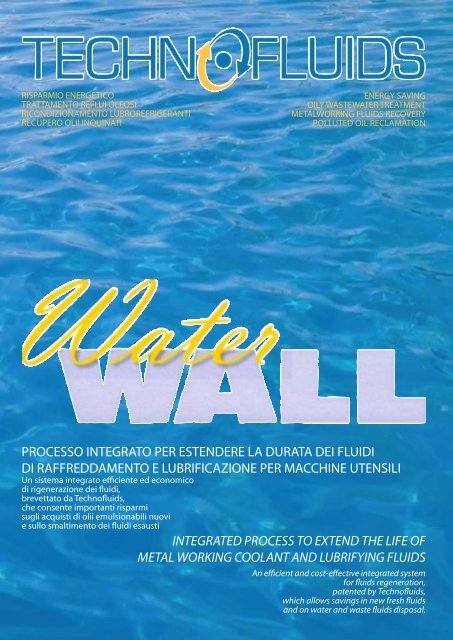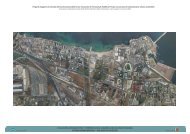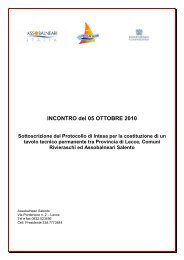Water Wall ® della Technofluids S.r.l. - AmbienteAmbienti
Water Wall ® della Technofluids S.r.l. - AmbienteAmbienti
Water Wall ® della Technofluids S.r.l. - AmbienteAmbienti
Create successful ePaper yourself
Turn your PDF publications into a flip-book with our unique Google optimized e-Paper software.
RISPARMIO ENERGETICO<br />
TRATTAMENTO REFLUI OLEOSI<br />
RICONDIZIONAMENTO LUBROREFRIGERANTI<br />
RECUPERO OLII INQUINATI<br />
ENERGY SAVING<br />
OILY WASTEWATER TREATMENT<br />
METALWORKING FLUIDS RECOVERY<br />
POLLUTED OIL RECLAMATION<br />
PROCESSO INTEGRATO PER ESTENDERE LA DURATA DEI FLUIDI<br />
DI RAFFREDDAMENTO E LUBRIFICAZIONE PER MACCHINE UTENSILI<br />
Un sistema integrato efficiente ed economico<br />
di rigenerazione dei fluidi,<br />
brevettato da <strong>Technofluids</strong>,<br />
che consente importanti risparmi<br />
sugli acquisti di olii emulsionabili nuovi<br />
e sullo smaltimento dei fluidi esausti<br />
INTEGRATED PROCESS TO EXTEND THE LIFE OF<br />
METAL WORKING COOLANT AND LUBRIFYING FLUIDS<br />
An efficient and cost-effective integrated system<br />
for fluids regeneration,<br />
patented by <strong>Technofluids</strong>,<br />
which allows savings in new fresh fluids<br />
and on water and waste fluids disposal.
ENERGY SAVING - OILY WASTEWATER TREATMENT - METALWORKING FLUIDS RECOVERY - POLLUTED OIL RECLAMATION<br />
COSA FA<br />
Mediante un processo costituito da una precisa sequenza<br />
di specifiche tecnologie, rimuove dai fludi refrigeranti tutte<br />
le particelle solide e liquide disperse nel fluido quali:<br />
- Residui di polveri di lavorazione (fino a 0,5 µ)<br />
- Olii estranei all’emulsione (olii idraulici, olii guide, etc.)<br />
- Sporcizia derivante dalla lavorazione<br />
Oltre a tutto questo, e non meno importante, il sistema<br />
<strong>Water</strong><strong>Wall</strong> controlla, inibendola, la proliferazione dei batteri<br />
anaerobici che si formano nell’emulsione durante la<br />
sua permanenza nelle vasche di raccolta.<br />
UTILITÀ<br />
Aumento <strong>della</strong> durata del refrigerante<br />
mediante l’utilizzo del sistema <strong>Water</strong><strong>Wall</strong> è possibile<br />
prolungare la durata del refrigerante fino a 2 anni (e oltre)<br />
sempre al massimo dell’efficacia.<br />
Aumento <strong>della</strong> qualità <strong>della</strong> lavorazione<br />
attraverso l’eliminazione del pulviscolo (fino a 0,5 µ)<br />
disperso nell’acqua. Se non eliminato questo potrebbe arrivare<br />
a trovarsi nel punto di contatto tra pezzo e utensile,<br />
compromettendo la qualità <strong>della</strong> finitura <strong>della</strong> lavorazione<br />
(oltre alla qualità e alla durata dell’utensile).<br />
Aumento <strong>della</strong> durata degli utensili<br />
eliminando gli olii estranei (olio guide – olio idraulico) non<br />
miscelati all’emulsione e micronizzati dalla pompa centrifuga<br />
<strong>della</strong> vasca di raccolta. Queste particelle, trovandosi nel<br />
punto di contatto tra utensile e materiale durante la lavorazione,<br />
a causa del calore sprigionato dall’attrito fondono<br />
creando particelle di carbonio che si fissano sugli utensili,<br />
limitandone la durata e la qualità <strong>della</strong> finitura.<br />
Miglioramento delle condizioni ambientali<br />
eliminando i batteri anaerobici che si sviluppano durante<br />
la permanenza dell’emulsione nella vasca di raccolta e che<br />
sono responsabili di infezioni all’apparato respiratorio e<br />
urinario.<br />
Minori volumi di refrigerante in acquisto e in smaltimento<br />
grazie al prolungamento <strong>della</strong> durata del refrigerante<br />
diminuiscono i volumi, facendo calare considerevolmente<br />
i costi di smaltimento e facilitando la gestione e la tenuta<br />
degli appositi registri.<br />
WHAT IT DOES<br />
By a process made by a precise sequence of spefical technologies,<br />
it removes from cooling fluids all solid and liquid<br />
particles dispersed on the fluid like:<br />
- Residual of swarfs and fines (up to 0,5 µ)<br />
- Tramp oil (hydraulic oils, guide’s oil, etc.)<br />
- Dirty given by the metalworking process<br />
Furthermore, and not less important, the <strong>Water</strong><strong>Wall</strong> system<br />
controls, inhibiting it, the growt of anaerobic bacteria that<br />
feed upon the coolant during its stay inside the collecting<br />
tanks.<br />
UTILITY<br />
Increase of coolant life<br />
by using the <strong>Water</strong><strong>Wall</strong> system it is possible to extend the life<br />
of the coolant up to 2 years (and more) always at the maximum<br />
performance capacity.<br />
Enhancement of the production quality<br />
by removing the powders (up to 0,5 µ) dispersed on the<br />
water. If not removed this could arrive on the contact side<br />
between piece and tool, compromising the quality of the<br />
process finishing (further to the quality and the life of the<br />
tool).<br />
Extension of the tool’s life<br />
removing the tramp oil (guides oil – hydraulic oil) not mixed<br />
in the coolant and micronized by the centrifugal pump of the<br />
collecting tank. When these particles arrive in the contact<br />
point between tool and material, cause of the<br />
heat given by the friction, they melt creating carbon particles<br />
that fix on the tools, limiting their life and the finishing quality.<br />
Improvement of the ambient conditions<br />
removing the anaerobic bacteria that grow during the<br />
permanence of the coolant inside the collecting tank and<br />
that are responsibles of infections on respiratory and urinary<br />
apparatus.<br />
Lower volumes of coolants to buy and to dispose of<br />
thanks to the increased coolant life, the volumes considerably<br />
decrease, lowering as consequence the disposal costs and<br />
making easier the management of the relevant loogbooks.
DESCRIZIONE DEL PROCESSO WATER WALL<br />
Il processo che caratterizza il sistema <strong>Water</strong> <strong>Wall</strong> è basato<br />
sulla creazione di una tensione di interfaccia addizionale tra<br />
le gocce d’olio ed il supporto filtrante <strong>Water</strong> <strong>Wall</strong>.<br />
Questa tensione interfacciale addizionale porta alla repulsione<br />
delle gocce d’olio dalla superficie dell’interfaccia di supporto<br />
liquido-liquido (<strong>Water</strong> <strong>Wall</strong>). Detta repulsione si ottiene<br />
controllando la velocità di ”filtrazione”.Il fenomeno è direttamente<br />
dipendente dalla superficie dell’interfaccia <strong>Water</strong> <strong>Wall</strong>,<br />
dal flusso che l’attraversa,dalla dimensione delle goccioline di<br />
olio e dalle proprietà fisiche dell’olio e dell’acqua da separare.<br />
Un addizionale effetto di filtrazione, a letto profondo, è stato<br />
rilevato sulle goccioline submicrometriche di olio, che in<br />
condizioni di flusso incontrollato, potrebbero essere in grado<br />
di passare attraverso la barriera di tensione interfacciale.<br />
In generale si ottiene una rimozione dell’olio dell’ordine del<br />
99,9%.<br />
Inoltre <strong>Technofluids</strong>, se richiesto, è anche in grado di installare<br />
un trattamento di “polishing” finale che può consentire<br />
di raggiungere un contenuto di olio residuo nelle acque<br />
separate inferiore a 1 mg/l (1 ppm).<br />
Il processo <strong>Water</strong> <strong>Wall</strong> non impiega cartucce filtranti o altri<br />
materiali di consumo che aumentano i costi e provocano<br />
problemi di smaltimento. La superficie del <strong>Water</strong> <strong>Wall</strong> che<br />
consente di ottenere l’efficienza di separazione richiesta si<br />
definisce a livello progettuale, sulla base delle caratteristiche<br />
tipiche dei fluidi da trattare e in particolare sulla base <strong>della</strong><br />
dimensione e distribuzione delle goccioline di olio; in alcuni<br />
casi la portata di separazione ottenibile può raggiungere i 40<br />
m3/h per metro quadro di superficie filtrante bifase.<br />
WATER WALL PROCESS DESCRIPTION<br />
The process underlying the <strong>Water</strong> <strong>Wall</strong> system is based on<br />
the creation of an additional interface tension between oil<br />
droplets and the filtering support <strong>Water</strong> <strong>Wall</strong>.<br />
This additional interface tension leads to the rejection of oil<br />
droplets on the top of the liquid-liquid interface support<br />
(<strong>Water</strong> <strong>Wall</strong>). This rejection is obtained controlling the “filtering”<br />
speed. The phenomena is directly depending from the<br />
interface surface <strong>Water</strong> <strong>Wall</strong>, the flow-rate, the droplets size<br />
and the phisical properties of oil and water to separate.<br />
An additional deep bed filtration effect has been observed<br />
on sub-micrometric droplets which, in uncontrolled flow<br />
conditions, may be able to pass through the interfacial tension<br />
barrier.<br />
Generally can be achieved an oil removal in the order of<br />
99,9%.<br />
Furthermore <strong>Technofluids</strong>, if required, is in position to install<br />
and additional “polishing” treatment that can allow to reach<br />
a residual oil content in the separated water of less than 1<br />
mg/l (1 ppm).<br />
The <strong>Water</strong> <strong>Wall</strong> process uses no filter cartridges or other disposables<br />
that increase costs and cause disposal problems.<br />
The surface of <strong>Water</strong> <strong>Wall</strong> that allows to reach the separating<br />
efficiency required is defined at design level, basing on<br />
the tipical characteristics of the fluids to treat and particularly<br />
basing on the size and distribution of oil droplets; in<br />
some application the flow rate obtainable can reach 40<br />
m3/h per square meter of two-layer filtering layer.
CARATTERISTICHE PARTICOLARI<br />
Il sistema lavora esclusivamente secondo un principio<br />
fisico, quindi senza aggiunta di alcun additivo chimico (solitamente<br />
per l’eliminazione delle cariche batteriche).<br />
Grazie a questo principio i costi di conduzione sono limitatissimi.<br />
APPLICAZIONI TIPICHE<br />
Essendo la caratteristica principale del <strong>Water</strong> <strong>Wall</strong> quella di<br />
respingere gli olii/idrocarburi dispersi così come rimuovere<br />
i solidi sospesi, l’impiego di questa tecnologia viene utilmente<br />
esteso ad una grande varietà di applicazioni, quali:<br />
INDUSTRIA MECCANICA<br />
- Lavorazione metalli: fluidi solubili in acqua, semi sintetici,<br />
sintetici e bio stabili utilizzati in rettifica, tornitura e<br />
geralmente nelle macchine utensili<br />
- Finitura metalli: acidi solubili in acqua, liquidi di pulizia<br />
alcalini e neutri contenenti oli liberi ed oli estranei<br />
dispersi<br />
- Filettatrici: oli estranei provenienti da fluidi solubili<br />
nell’acqua utilizzati nei serbatoi delle filettatrici<br />
APPLICAZIONI MARINE<br />
- Separazione oli/ idrocarburi da acque di sentina<br />
- Disoleazione delle acque di zavorra<br />
- Disoleazione delle acque marine<br />
- Protezione impianti di desalinizzazione<br />
OIL & GAS<br />
- Trattamento acque di produzione, di reiniezione e<br />
smaltimento<br />
- Recupero fluidi di saturazione<br />
- Trattamento acque di raffineria<br />
- Trattamento acque marine di reiniezione<br />
INDUSTRIA ALIMENTARE CHIMICA E FARMACEUTICA<br />
- Recupero acque di processo<br />
- Trattamento acque reflue<br />
ENERGY SAVING - OILY WASTEWATER TREATMENT - METALWORKING FLUIDS RECOVERY - POLLUTED OIL RECLAMATION<br />
SPECIAL FEATURES<br />
The system works exclusively by a phisical principle, so<br />
without adding any chemical additive (usually for the<br />
removal of the bacteria).<br />
Thanks to this principle the operating costs are really limited.<br />
TYPICAL APPLICATIONS<br />
Since <strong>Water</strong> <strong>Wall</strong> process package strongly repels free oils<br />
as well as suspended solids, the use of this technology is<br />
usefully applied for a wide variety of applications, such as:<br />
MECHANICAL INDUSTRY<br />
- Metal working: water soluble, semi synthetic, synthetic<br />
and bio stable fluids used in grinding, turning and general<br />
machining operations<br />
- Metal finishing: water soluble acid, alkaline and neutral<br />
cleaners containing free and mechanically dispersed<br />
tramp oils<br />
- Screw machines: tramp oil from water soluble fluids used<br />
in screw machine reservoires<br />
MARINE APPLICATIONS<br />
- Bilge water separation<br />
- Tank ballast water de-oiling<br />
- Sea water de-oiling<br />
- Desalination plant protection<br />
OIL & GAS<br />
- Produced water - Reinjection and disposal<br />
- Completion fluids recovery<br />
- Refinery run-off water<br />
- Seawater injection<br />
FOOD, CHEMICAL & PHARMACEUTICAL INDUSTRIES<br />
- Process water recovery<br />
- Wastewater treatment<br />
<strong>Technofluids</strong> S.r.l.<br />
Via A. De Gasperi, 37 - 42012 Campagnola Emilia (RE)<br />
Tel +39 0522 750220 - Fax +39 0522 753288<br />
mail: info@technofluids.com - www.technofluids.com




